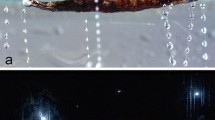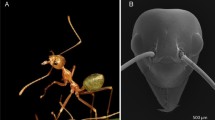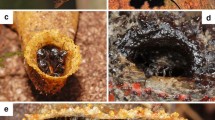Abstract
The European hummingbird hawkmoth Macroglossum stellatarum is a diurnal nectar forager like the honeybee, and we expect similarities in their sensory ecology. Using behavioural tests and electroretinograms (ERGs), we studied the spectral sensitivity of M. stellatarum. By measuring ERGs in the dark-adapted eye and after adaptation to green light, we determined that M. stellatarum has ultraviolet (UV), blue and green receptors maximally sensitive at 349, 440 and 521 nm, and confirmed that green receptors are most frequent in the retina. To determine the behavioural spectral sensitivity (action spectrum) of foraging moths, we trained animals to associate a disk illuminated with spectral light, with a food reward, and a dark disk with no reward. While the spectral positions of sensitivity maxima found in behavioural tests agree with model predictions based on the ERG data, the sensitivity to blue light was 30 times higher than expected. This is different from the honeybee but similar to earlier findings in the crepuscular hawkmoth Manduca sexta. It may indicate that the action spectrum of foraging hawkmoths does not represent their general sensory capacity. We suggest that the elevated sensitivity to blue light is related to the innate preference of hawkmoths for blue flowers.





Similar content being viewed by others
References
Balkenius A, Rosén W, Kelber A (2006) The relative importance of olfaction and vision in a diurnal and a nocturnal hawkmoth. J Comp Physiol A 192:431–437
Barrozo RB, Jarriault D, Deisig N, Gemeno C, Monsempes C, Lucas P, Gadenne C, Anton S (2011) Mating-induced differential coding of plant odour and sex pheromone in a male moth. Eur J Neurosci 33:1841–1850
Bennett RR, Brown PK (1985) Properties of the visual pigments of the moth Manduca sexta and the effect of two detergents, digitonin and CHAPS. Vis Res 25:1771–1781
Brandt R, Vorobyev M (1997) Metric analysis of increment threshold spectral sensitivity in the honeybee. Vis Res 37:425–439
Cutler DE, Bennett RR, Stevenson RD, White RH (1995) Feeding behavior in the nocturnal moth Manduca sexta is mediated by blue receptors but where are they in the retina? J Exp Biol 198:1909–1917
Frisch KV (1914) Der Farbensinn und Formensinn der Biene. Zool J Physiol 37:1–238
Goldsmith TH, Butler BK (2003) The roles of receptor noise and cone oil droplets in the photopic spectral sensitivity of the budgerigar, Melopsittacus undulatus. J Comp Physiol A 189:135–142
Govardovskii VI, Fyhrquist N, Reuter T, Kuzmin DG, Donner K (2000) In search of the visual pigment template. Vis Neurosci 17:509–528
Goyret J, Kelber A (2011) How does a diurnal hawkmoth find nectar? Differences in sensory control with a nocturnal relative. Behav Ecol 22:976–984. doi:10.1093/beheco/arr078
Goyret J, Kelber A (2012) Chromatic signals control proboscis movements during hovering flight in the hummingbird hawkmoth Macroglossum stellatarum. PLoS One 7(4):e34629. doi:10.1371/journal.pone.0034629
Goyret J, Pfaff M, Raguso RA, Kelber A (2008) Why do Manduca sexta feed from white flowers? Innate and learnt colour preferences in a hawkmoth. Naturwissenschaften 95:569–576
Hasselmann E-M (1962) Über die relative spektrale Empfindlichkeit von Käfer- und Schmetterlingsaugen bei verschiedenen Helligkeiten. Zoo Jb Physiol 69:537–576
Helversen OV (1972) Zur spektralen Unterschiedsempfindlichkeit der Honigbiene. J Comp Physiol 80:439–472
Höglund GK, Hamdorf K, Rosner G (1973) Trichromatic visual system in an insect and its sensitivity control by blue light. J Comp Physiol 86:265–279
Kelber A (1996) Colour learning in the hawkmoth Macroglossum stellatarum. J Exp Biol 199:1127–1131
Kelber A (1997) Innate preferences for flower features in the hawkmoth Macroglossum stellatarum. J Exp Biol 200:826–835
Kelber A (2002) Pattern recognition in a hawkmoth: innate preferences, learning and ecology. Proc R Soc Lond B 269:2573–2577
Kelber A (2005) Alternative use of chromatic and achromatic cues by a diurnal hawkmoth. Proc R Soc Lond B 272:2143–2147. doi:10.1098/rspb.2005.3507
Kelber A, Balkenius A (2007) Sensory ecology of feeding in the hummingbird hawkmoth Macroglossum stellatarum L. (Lepidoptera, Sphingidae). Ent Gen 29:97–110
Kelber A, Hénique U (1999) Trichromatic colour vision in the hummingbird hawkmoth Macroglossum stellatarum. J Comp Physiol A 184:535–541
Knoll F (1922) Lichtsinn und Blumenbesuch des Falters von Macroglossum stellatarum. Abhandl Zool Botanischen Ges Wien 12:121–377
Knoll F (1926) Lichtsinn und Blütenbesuch des Falters von Deilephila livornica. Zeitschrift für vergleichende Physiol 2:328–380
Koshitaka H, Kinoshita M, Vorobyev M, Arikawa K (2008) Tetrachromacy in a butterfly that has eight varieties of spectral receptors. Proc R Soc B 275:947–954
Lind O, Chavez J, Kelber A (2014) The relative contribution of single and double cones to spectral sensitivity in budgerigars during changing light conditions. J Comp Physiol A. doi:10.1007/s00359-013-0878-7
Prins N, Kingdom FAA (2009) Palamedes: Matlab routines for analyzing psychophysical data. version 1.5.0. http://www.palamedestoolbox.org. Accessed 8 Oct 2012
Schlecht P, Hamdorf K, Langer H (1978) The arrangement of colour receptors in a fused rhabdom of an insect: a microspectrophotometric study on the moth Deilephila. J Comp Physiol 123:239–243
Schwemer J, Paulsen R (1973) Three visual pigments in Deilephila elpenor (Lepidoptera, Sphingidae). J Comp Physiol 86:215–229
Siju KP, Hill SR, Hansson BS, Ignell R (2010) Influence of blood meal on the responsiveness of olfactory receptor neurons in antennal sensilla trichodea of the yellow fever mosquito, Aedes aegypti. J Insect Physiol 56:659–665
Stavenga DG (2010) On visual pigment templates and the spectral shape of invertebrate rhodopsins and metarhodopsins. J Comp Pysiol A 196:869–878
Vogt K (1989) Distribution of insect visual chromophores: functional and phylogenetic aspects. In: Stavenga DG, Hardie RC (eds) Facets of vision. Springer, Berlin, pp 134–151
Vorobyev M, Osorio D (1998) Receptor noise as a determinant of colour thresholds. Proc R Soc Lond B 265:351–358
Vorobyev M, Brandt R, Peitsch D, Laughlin SB, Menzel R (2001) Colour thresholds and receptor noise: behaviour and physiology compared. Vis Res 41:639–653
Wakakuwa M, Stewart F, Matsumoto Y, Matsunaga S, Arikawa K (2014) Physiological basis of phototaxis to near infrared light in Nephotettix cincticeps. J Comp Physiol. doi:10.1007/s00359-014-0892-4
White RH, Huihong X, Münch TH, Bennett RR, Grable EA (2003) The retina of Manduca sexta: rhodopsin expression, the mosaic of green-, blue- and UV-sensitive photoreceptors, and regional specialization. J Exp Biol 206:3337–3348
Wichmann FA, Hill NJ (2001) The psychometric function: I. Fitting, sampling, and goodness of fit. Percept Psychophys 63:1293–1313
Xu P, Lu B, Xiao H, Fu X, Murphy RW, Wu K (2013) The evolution and expression of the moth visual opsin family. PLoS One 8(10):e78140. doi:10.1371/journal.pone.0078140
Acknowledgments
We thank Alejandro Trillo for catching wild moths and collecting eggs in Spain and Michael Pfaff and Samantha Goyret for enduring help with breeding Macroglossum stellatarum. We are grateful to Michael Pfaff for help with building the flight cage, to Eric Warrant for sharing electrophysiology equipment, to the Lund Vision Group for inspiring discussions and to two referees for constructive comments. We gratefully acknowledge financial support from the Swedish Research Council (grant 621-2009-5683) and the Wenner-Gren foundation to AK, from CSIC Studentship JAE PRE (2011: ESTCSIC-6715 and 2012: ESTCSIC-7853) to FJT and from the Spanish Ministerio de Ciencia e Innovación/FEDER (project CGL2010-16795) to MARG.
Author information
Authors and Affiliations
Corresponding author
Electronic supplementary material
Below is the link to the electronic supplementary material.
Rights and permissions
About this article
Cite this article
Telles, F.J., Lind, O., Henze, M.J. et al. Out of the blue: the spectral sensitivity of hummingbird hawkmoths. J Comp Physiol A 200, 537–546 (2014). https://doi.org/10.1007/s00359-014-0888-0
Received:
Revised:
Accepted:
Published:
Issue Date:
DOI: https://doi.org/10.1007/s00359-014-0888-0




